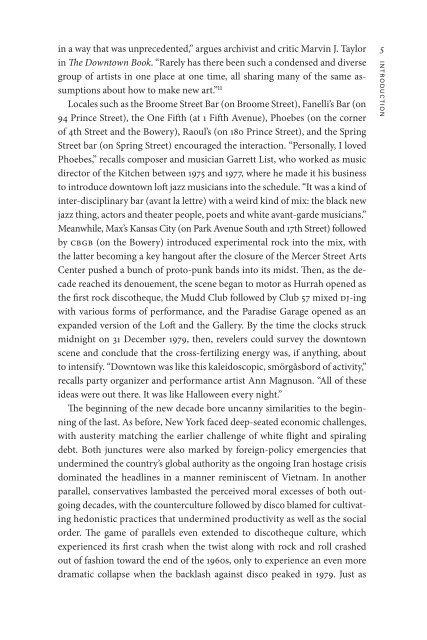TIM LAWRENCE
2c4flOA
2c4flOA
You also want an ePaper? Increase the reach of your titles
YUMPU automatically turns print PDFs into web optimized ePapers that Google loves.
in a way that was unpre ce dented,” argues archivist and critic Marvin J. Taylor<br />
in The Downtown Book. “Rarely has there been such a condensed and diverse<br />
group of artists in one place at one time, all sharing many of the same assumptions<br />
about how to make new art.” 11<br />
Locales such as the Broome Street Bar (on Broome Street), Fanelli’s Bar (on<br />
94 Prince Street), the One Fifth (at 1 Fifth Ave nue), Phoebes (on the corner<br />
of 4th Street and the Bowery), Raoul’s (on 180 Prince Street), and the Spring<br />
Street bar (on Spring Street) encouraged the interaction. “Personally, I loved<br />
Phoebes,” recalls composer and musician Garrett List, who worked as music<br />
director of the Kitchen between 1975 and 1977, where he made it his business<br />
to introduce downtown loft jazz musicians into the schedule. “It was a kind of<br />
inter- disciplinary bar (avant la lettre) with a weird kind of mix: the black new<br />
jazz thing, actors and theater people, poets and white avant- garde musicians.”<br />
Meanwhile, Max’s Kansas City (on Park Ave nue South and 17th Street) followed<br />
by cbgb (on the Bowery) introduced experimental rock into the mix, with<br />
the latter becoming a key hangout after the closure of the Mercer Street Arts<br />
Center pushed a bunch of proto- punk bands into its midst. Then, as the decade<br />
reached its denouement, the scene began to motor as Hurrah opened as<br />
the first rock discotheque, the Mudd Club followed by Club 57 mixed dj- ing<br />
with vari ous forms of per for mance, and the Paradise Garage opened as an<br />
expanded version of the Loft and the Gallery. By the time the clocks struck<br />
midnight on 31 December 1979, then, revelers could survey the downtown<br />
scene and conclude that the cross- fertilizing energy was, if anything, about<br />
to intensify. “Downtown was like this kaleidoscopic, smörgåsbord of activity,”<br />
recalls party or ga nizer and per for mance artist Ann Magnuson. “All of these<br />
ideas were out there. It was like Halloween every night.”<br />
The beginning of the new de cade bore uncanny similarities to the beginning<br />
of the last. As before, New York faced deep- seated economic challenges,<br />
with austerity matching the earlier challenge of white flight and spiraling<br />
debt. Both junctures were also marked by foreign- policy emergencies that<br />
undermined the country’s global authority as the ongoing Iran hostage crisis<br />
dominated the headlines in a manner reminiscent of Vietnam. In another<br />
parallel, conservatives lambasted the perceived moral excesses of both outgoing<br />
de cades, with the counterculture followed by disco blamed for cultivating<br />
hedonistic practices that undermined productivity as well as the social<br />
order. The game of parallels even extended to discotheque culture, which<br />
experienced its first crash when the twist along with rock and roll crashed<br />
out of fashion toward the end of the 1960s, only to experience an even more<br />
dramatic collapse when the backlash against disco peaked in 1979. Just as<br />
5<br />
INTRODUCTION


